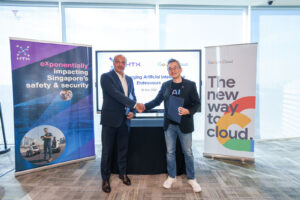Brought to you by Keysight Technologies
By Ee Huei Sin

Rapidly evolving technologies across cloud, digital twins and artificial intelligence, 5G and 6G, quantum computing, and electric and autonomous vehicles are powering innovation across industries.
Keysight Technologies supports development of these and other technologies by delivering advanced design and validation solutions, from software-driven insights and analytics that bring tomorrow’s technology products to market faster across the development lifecycle, to design simulation, prototype validation, automated software testing, manufacturing analysis, and network performance optimisation and visibility in enterprise, service provider and cloud environments.
As the world’s leading test and measurement provider, Keysight’s customers span the worldwide communications and industrial ecosystems, aerospace and defense, automotive, energy, semiconductor and general electronics markets, and it is well-placed to anticipate key developments affecting the Electrical and Electronic (E&E) and IT landscapes, in the future.
As we go into 2023, Keysight’s senior vice president, and president of the Electronic Industrial Solutions Group (EISG), Ee Huei Sin, offers the following predictions for key technologies for the new year and the years ahead.
Cloud cover to soften recession concerns
Concerns over a recession in 2023 will drive more enterprises to shift data intensive tasks to the cloud to reduce infrastructure and operational costs while also improving cybersecurity. This will also help organisations deliver greater data-driven customer experiences.
For example, advanced simulation and test data management capabilities such as real-time feature extraction and encryption will enable use of a secure cloud-based data mesh that will accelerate and deepen customer insights through new algorithms operating on a richer data set. In the year ahead, expect the cloud to be a surprising boon for companies as they navigate economic uncertainty.
While organisations have historically been hesitant to adopt network and cloud-based software and services due to security concerns, expect these to be addressed in 2023 through robust encryption capabilities and greater access control of measurement parameters and data, providing users with unparalleled assurance of data integrity from probe to cloud—and back.
As a result, we expect more cloud and network security investments to help enterprises protect the ever-expanding threat surface in the year ahead.
We can also expect automation and robotics to be in particularly high demand in a downturn. Expect heightened investment in tools that automate repetitive simulation and measurement tasks, ensure the validity of results by catching and fixing errors, and improve measurement quality by eliminating human-induced variability.
Through these and other automation capabilities, employees will be freed to act on the new insights gleaned and focus on other, more strategic initiatives.
The next five years will see data monetisation efforts accelerate, with CIOs favouring solutions with low code extensibility, intuitive user experience, and prolific API’s for maximum composability, all culminating in breakthrough analytical insights. But those who fail to embrace these capabilities will be mired in an Excel wormhole—the negative financial and competitive consequences of which will be difficult to escape.
Cybersecurity: the deepfake threat, hackers in your home, physical attacks
Security experts have warned for years about the possibility of social engineering attacks with deepfakes, and the technology has matured enough for 2023 to see hackers successfully leverage it.
We will see an increase in image generation, generated audio, and conversations that appear realistic, designed to trick recipients into sharing personal data or other sensitive information. The deepfake threat isn’t relegated solely to consumers; we’ll likely see threat actors spoof a Fortune 100 CEO in an attempt to defraud or otherwise damage the organisation.
With increased adoption of IoT devices, hackers will become a tangible threat within smart homes. Expect threat actors to infiltrate webcams, microphones, smart TVs and other connected devices, demanding money transfers or bank account details. As this happens, IoT manufacturers will have to formulate their response to IoT-based extortion.
Also expect 2023 to see more targeted Operational Technology attacks designed to disable or destroy system availability with the end goal of harming people. For example, ransomware attacks against life-saving equipment in the healthcare sector will become fair game.
Real-world use cases for digital twins and AI
We expect real-world use cases to emerge to show just how transformative the application of digital twins to physical systems can be for various sectors. These will range from healthcare to manufacturing to retail; from virtual caregivers/ companions to surgical AI assistants, to gaining insights on how decisions affect sustainability by modeling planned changes to see how an entire ecosystem can be impacted and adjusted.
Expect to see more companies cropping up next year to help further blur the line between the physical and virtual worlds.
With R&D efficiency a priority in 2023, we can also expect to see increased use of digital twins for system design and testing. This approach enables faster design cycles, more efficient co-design of hardware and software, a more robust product, and reduced costs while also delivering benefits in improved manufacturability and serviceability.
In the coming year, we anticipate a shift to connected platforms in which complete products are designed and tested via a digital twin.
At the same time, product recall rates are set to rise between 2023 and 2026. Pent-up demand for new products able to connect to 5G capacity was already putting pressure on developers before the worldwide pandemic shutdowns.
Follow-on supply chain issues, which made many parts scarce, caused rapid redesigns of products using substitute parts, with many not designed to the same specifications. As a result, we expect there will be an increase in product failures as a wave of these products hits the market.
Faster 5G rollouts are accelerating demand and expectations for adjacent advances in complex technologies like autonomous driving, new distributed IoT applications, and the rollout of metaverse capabilities.
Products involving this level of complexity need to meet more compliance and connectivity standards, operate across a much wider range of often unknown conditions, and are expected to be backward compatible with other systems that are not yet in the market.
As a result, we anticipate that product developers will be tempted to build do-it-yourself (DIY) digital twins instead of buying them. But those taking DIY shortcuts may lead a spike in product recalls.
6G will open new doors
Moving forward, aggressive showcase objectives will become more visible for 6G with the 2025 Osaka World Expo as a big showcase and the 2028 Los Angeles Summer Olympics welcoming 6G to the global stage. We can probably expect one of the two opening ceremonies to happen in the metaverse.
The metaverse will feature prominently in the user experience, enabling fans to participate in some Olympic events. We’ll also see certain sports and, potentially, eSports run a 6G metaverse Olympics in parallel with the actual games, with at least one medal awarded within the metaverse.
As brands draw inspiration from the Olympics, there will be a subsequent explosion of 6G use cases and we may see big tech companies becoming new tier one mobile network operators.
While rural areas and remote industries will benefit from the enhanced connectivity of 6G, and network ultra-low latency will further accelerate high-speed finance, the technology will be far more expensive than its predecessors so adoption disparities can be expected.
The industry is also running short on spectrum, which will ultimately become a barrier to future technologies. Therefore, expect the 2030s to focus on solving the spectrum challenges in order to allow future network innovations to thrive.
Quantum starts to realise its potential
For fields ranging from cybersecurity to materials creation, financial analysis to military receivers, recent research revealed that 74 per cent of companies believe they will fall behind if they fail to adopt quantum. As a result, organisations will begin to address key challenges, including financial resources and operations, to develop real enterprise applications of quantum by 2026, if not sooner.
Take the airline industry, for example. It’s not uncommon for companies to spend 25 years on complex design processes, such as the design of a new polymer that will make planes more fuel efficient, resistant to temperatures, etc, but quantum computing and engineering solutions will significantly accelerate this and other material science design timelines. Rather than spending their entire career on one design cycle, employees will be able to complete the process in a matter of years.
Quantum technology can also facilitate navigation in remote areas with minimal satellite coverage, although cost is currently a barrier to adoption. But as quantum becomes more prevalent and affordable, we will see emergency vehicles equipped with quantum sensors—with consumer vehicles eventually following suit.
And once quantum demonstrates advantage, it will be channeled to help fight climate change – for example, by improving decision-making through complex modeling and predictions,
and enabling meteorologists to better predict trajectories of hurricanes, winter storms, and other weather events.
Electric vehicles will drive more integrated and intelligent energy consumption
Innovations in electric (EVs) and autonomous vehicles (AVs) continue apace, but challenges remain in large-scale charging, charging infrastructure and battery technology advances needed to drive range and cost improvements.
Electric vehicle range anxiety will remain until 300+ miles is standard on a single charge and high-speed charging in under 10 minutes is readily available. Until then, commercial vehicles will remain gas guzzlers. Electric vehicles will also require adoption of common standards by the entire ecosystem to be mainstream across the globe; and battery innovation such as silicon anodes and solid-state batteries will be needed to overcome barriers to adoption.
We expect that EVs will start to become an energy repository for users, whether on the road or in their homes. Intelligent applications will use calendars to determine the energy required for the next day’s travel and individuals will utilise remaining battery power for their home energy needs. Major power providers are expected to awaken to this possibility by 2025 and be forced to reimagine static grid infrastructures.
We also expect new adoption to come from the construction industry, which can utilise EVs’ excess energy to power machinery that previously required cumbersome generators or numerous extension cords to function.
While younger generations don’t see cars as status symbols, and embrace the “Uberisation” of vehicles— the idea that a car just needs to get you from point A to point B with minimal environmental impact, the same can’t be said for Boomers and Gen X.
To meet the greener energy deadlines of 2035, it’s vital that these groups change their thinking. Expect this to be a key focus area in 2023 in many countries, with numerous campaigns aimed at educating older demographics about the need for EVs.
Carbon reduction
Meeting government mandates and societal imperatives for carbon reduction will continue to be a focus in 2023. AI/ML enabled optimisations based on measurement and monitoring of industrial and commercial infrastructure, such as data networks, will drive the next level of energy use management.
Ee Huei Sin is President, Electronic Industrial Solutions Group, Keysight Technologies






